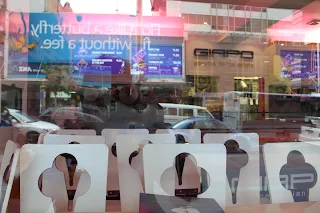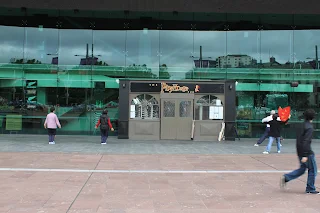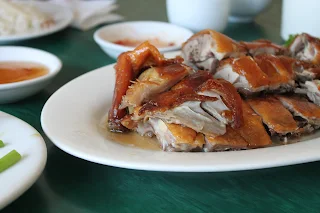New Zealand excites more with its outdoor possibilties, scenic panaromas and adventure sport sites than its urban landscapes and activities. Having acknowledged that, I sought to find the best of Auckland city centre. Auckland, New Zealand's largest city by population and area, calls for comparisons with Sydney in Australia. Auckland has sloping, hilly roads, combined with a beautiful harbour of varied and many bays and inlets. It also has a Harbour Bridge and more - the isles in Auckland Harbour, like Rangitoto, are bigger than Sydney's and its suburban roads are wider and perhaps more well planned. Many of the Auckland suburbs sit on extinct volcanic sites, hence all the Mounts from Albert to Eden, as the place straddles the Auckland Volcanic Field. In the city centre itself, however, life is more simple than Sydney's sprawling version. Above image, preparations for Christmas and New Year' Eve as parts of giant baubles are laid on a courtyard.

Life does still revolve around cafes, fruit juice bars and pubs. Above, looking through the glass of a Italian styled coffee place on an early Monday morning. Queen Street is one long hilly thoroughfare around which Auckland downtown personifies. On my November 2011 visit, I noted the emergence of more students, Asian businesses and a lively scene during evenings. The Korean and Chinese presence in Auckland are more pronounced. There still are heritage buildings and long standing Kiwi establishments like Whitcoulls, the Town Hall and Civic Theatre. Joining them now are the Red Guard Noodle Bar, curry houses and the new fangled Burger Fuel joints.

Rupert Murdoch, the ASB Bank Buildng and an ANZ Bank mrketing campaign motto ("Float Like a Butterfly, Fix without a Fee") all stare at you as you walk down from the top end of Queen Street. (picture above) Below, a few practitioners of tai chi and flag waving exercise in front of the main Auckland cinema complex in the city.

Kiwi architecture and interior design can be inspring and refreshing, as exemplfied by the counter of the box office at the entertainment centre, next showing the live performance of the Jersey Boys from April 2012. (image above). This contrasts with the feel and look of shopfronts of Asian chains like Japanese Daiso below.


Aotea Square is a landmark site not to be missed (picures above and below). When I wandered there, the denizens of the protest movement Occupy Auckland had just awoken from their slumber outdoors, albeit with camping tents, in the best tradition of New Zealand adventure and life. Aotea is named after Motu Aotea, or the Great Barrier Island, whch lies off 90 km from Auckland Harbour and is the largest off shore island for New Zealand.


Auckland is named after George Eden, Earl of Auckland in the UK and is the largest Polynesian city in the world. It continues to have a third of the population of New Zealand, and is sited to be blessed with both the Tasman Sea and South Pacific. Trams used to run in Auckland after Pakeha settlement. Preceding that were many Maori traditional villages called pa which existed from around 1350.


Aotea Square is a landmark site not to be missed (picures above and below). When I wandered there, the denizens of the protest movement Occupy Auckland had just awoken from their slumber outdoors, albeit with camping tents, in the best tradition of New Zealand adventure and life. Aotea is named after Motu Aotea, or the Great Barrier Island, whch lies off 90 km from Auckland Harbour and is the largest off shore island for New Zealand.


Auckland is named after George Eden, Earl of Auckland in the UK and is the largest Polynesian city in the world. It continues to have a third of the population of New Zealand, and is sited to be blessed with both the Tasman Sea and South Pacific. Trams used to run in Auckland after Pakeha settlement. Preceding that were many Maori traditional villages called pa which existed from around 1350.
Above, the Auckland Town Hall, done in the Edwardian style, of which I had the privilege of attending Yin's graduation a few years ago. Below, the map of the route for the Auckland City Triathlon on 20 November 2011.


My favourite part of downtown Auckland is around the High Street precinct. Here are the side walk restaurants and cafes, cobbled and bricked pathways and a sense of the old quarter of the city (picture above). There are businesses with narrow shop fronts, those that lead you upstairs or to basements and all with a sense of uniqueness and ambiance. Some family members and I had a pub lunch of pizza and pasta at a quaint joint called Cassette.

The harbour front continues to be the jewel in Auckland city centre's crown, with the Viaduct and Wynyard Quarter the focus of night life and social events post game during the 2011 World Rugby Cup in New Zealand. Here fine dining, marina bays and the smell of the ocean remind any visitor of what Auckland City is mostly all about - the City of Sails.


My favourite part of downtown Auckland is around the High Street precinct. Here are the side walk restaurants and cafes, cobbled and bricked pathways and a sense of the old quarter of the city (picture above). There are businesses with narrow shop fronts, those that lead you upstairs or to basements and all with a sense of uniqueness and ambiance. Some family members and I had a pub lunch of pizza and pasta at a quaint joint called Cassette.

The harbour front continues to be the jewel in Auckland city centre's crown, with the Viaduct and Wynyard Quarter the focus of night life and social events post game during the 2011 World Rugby Cup in New Zealand. Here fine dining, marina bays and the smell of the ocean remind any visitor of what Auckland City is mostly all about - the City of Sails.














































